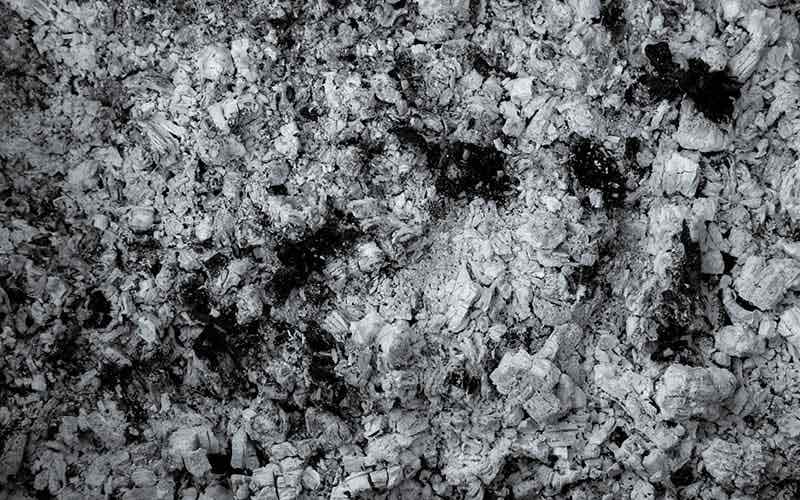
As New England states move towards Zero Waste, the amount of toxic ash produced from incineration will only decrease – meaning there's no need to expand ash landfills. Photo Credit: Volodymyr Hryshchenko via Unsplash
Time and time again, we’ve talked about waste incineration technologies and why they are dangerous. But what happens after commercial, residential, or hazardous waste gets burned in an incinerator? It doesn’t disappear. Instead, just like burning wood leaves behind a heap of ash, so does burning trash. The difference is that incinerator ash is toxic to human health and the environment.
And where does all that toxic ash go at the end of the day? In short, it’s taken to an ash landfill for waste companies to bury. The dangerous substances in that ash will inevitably leach out of the landfill as toxic garbage juice. That’s one of the reasons why trash incineration has started to fall out of favor as a method for “dealing with” waste. In fact, more than 40 incinerators in the U.S. have closed since 2000. Yet here in New England, 16 trash burners continue to operate. What’s more, all of them generate tons of toxic ash each year.
As New England’s incinerators limp on well past their lifespans, several ash landfills across the region want to expand. But we won’t let that happen without a fight. CLF is actively pushing back against the expansion of New England’s dangerous ash landfills – and we’re making progress.
The Harms of Incinerator Ash
Waste incineration produces two types of ash: bottom ash and fly ash. The heavier bottom ash settles on the incinerator floor, while the lighter fly ash can more easily escape through a facility’s smokestacks. Any fly ash that doesn’t escape is taken alongside the bottom ash to a landfill.
While both types of incinerator ash are hazardous, fly ash is particularly dangerous. That’s because it contains a high concentration of toxic compounds. These include dioxins, heavy metals (such as lead, mercury, cadmium, and arsenic), “forever chemicals” known as PFAS, and other poisonous compounds.
Scientists have linked exposure to these toxic substances to a host of health issues, including:
- higher rates of various cancers,
- problems with reproduction and fertility,
- impaired immune system and kidney function, and
- learning and developmental problems in children.
Communities living near the Wheelabrator Saugus incinerator and ash landfill in Massachusetts have experienced these impacts firsthand. In fact, one Saugus resident’s extended family, most of whom lived on the same street growing up, has faced myriad cancer diagnoses. While the area’s elevated cancer rates and other health issues cannot be linked definitively to the incinerator, residents believe they are all consequences of growing up and living near the toxic trash burner and landfill.
Fortunately, residents did have a reason to celebrate recently. The Massachusetts Department of Environmental Protection explained that the landfill’s owner, WinWaste Solutions (formerly Wheelabrator Technologies), would not be permitted to expand the toxic facility in the future, and that it will be closing in 2024.
The Problem with Ash Landfills
After our waste is burned to a crisp, the remaining ash gets sent to a landfill. But the toxic substances in incinerator ash do not stay put once buried. Smokestack emissions can literally fly away into the environment – spreading toxics throughout the air supply in the given region. And the ash that waste companies bury? The toxics leak out of it and accumulate as leachate (or garbage juice). This leachate seeps into our soil and groundwater – polluting natural resources and harming the wildlife that relies on those resources. What’s more, these toxics threaten the health of local communities.
Some landfills do have leak protection methods (like landfill liners) and testing requirements for toxic contaminants in landfill discharge. But these “safeguards” aren’t enough to protect surrounding communities and the environment. Research shows that landfill liners will develop holes and cracks as they age and degrade. This often happens within the first four years of the liner and ash being in the ground. That means leachate leaks are inevitable, and there’s no way to fully contain or remove the toxic substances in it.
If that weren’t bad enough, garbage juice can continuously leach out of landfills for thousands of years. That’s because, as rain and snowmelt seep through the ash, they drag toxic substances out with them.
Expanding Ash Landfills Is Dangerous and Unnecessary
Landfill expansions destroy or displace vital natural areas – like wetlands and forests – that benefit people. Plus, they increase the threat of toxic pollutants leaking into our soil and water. To make matters worse, the negative impacts of ash landfills are often shouldered by environmental justice communities already overburdened by air pollution and other environmental contaminants. Take the ash landfill in Bourne, Massachusetts.
As Cape Cod’s only facility for burying incinerator ash, the Bourne Landfill wants to expand by 25 acres. This expansion would accommodate 2.4 million more tons of waste. Yet, the landfill already leaks toxics into the ground – posing a substantial threat of PFAS contamination on the Cape.
Similarly, the Wheelabrator Putnam Landfill in Connecticut has been seeking authorization to more than double in size. Why? To make room for an additional 22 million tons of incinerator ash. Wheelabrator is already failing to adequately test or treat the ash and landfill leachate for PFAS. An expansion would only heighten the threat of pollutants running off into the Quinebaug River – an important Connecticut waterway. And, if approved, the expansion will destroy almost six acres of wetlands.
Due to high rates of poverty and unemployment, Putnam, Connecticut, has been designated as a “distressed community” by the State. And the area near the landfill in Bourne, Massachusetts, was recently classified as a low-income, environmental justice community. Expanding ash landfills in these towns furthers a known pattern of historically marginalized communities bearing the brunt of environmental degradation. That includes public health threats perpetuated by toxic waste systems. Expanding the landfills will only harm these communities more.
The Alternative? Zero Waste, Of Course!
CLF is working across New England to change laws and policies to better align with Zero Waste principles. And we’re making progress. Just last year, Connecticut decided to shut down its incinerator facility in Hartford come July 2022.
What’s more, Connecticut has committed to transitioning away from waste incineration. Instead, the state plans to move towards Zero Waste practices, like composting and container reuse. This includes shutting down more of the state’s five harmful trash incinerators, not just the Hartford facility.
As New England states move towards Zero Waste alternatives, the amount of toxic ash produced from incineration will only decrease. That’s why CLF is working to make sure these dangerous landfills don’t expand – and you can help.
Right now, the state environmental departments are reviewing the permit applications for the expansion of Massachusetts’ Bourne Ash Landfill and Connecticut’s Putnam Ash Landfill. To stay in the loop on New England’s polluting waste facilities, sign up for CLF’s emails. While our expertise is important, in the end, we need you in our corner to shut down New England’s dangerous waste facilities.
About the authors: Erica Kyzmir-McKeon is a Staff Attorney in CLF’s Clean Air & Water and Healthy Communities & Environmental Justice Programs. Huda Khwaja is a Charlotte E. Ray Legal Fellow based in CLF Vermont.



